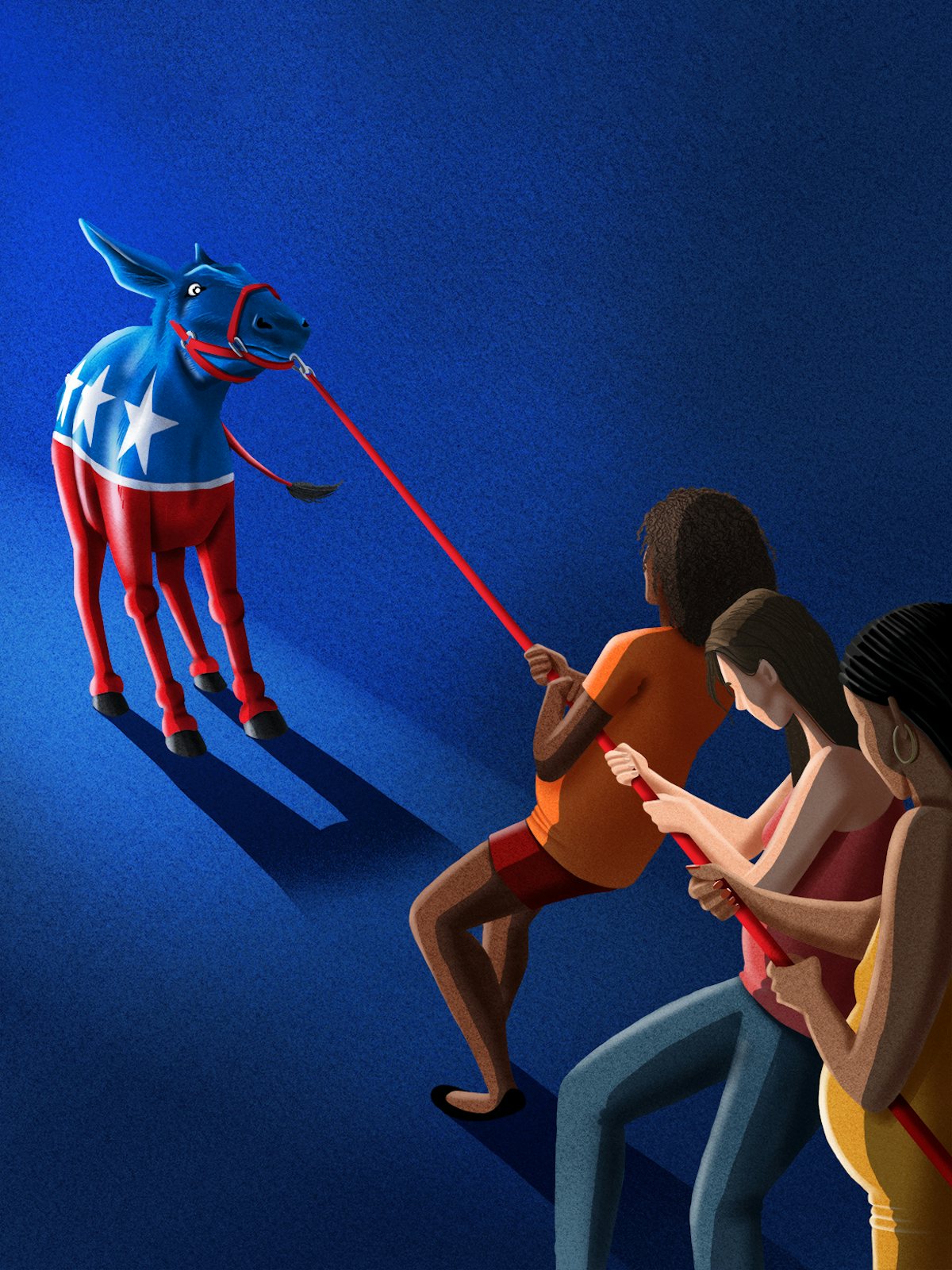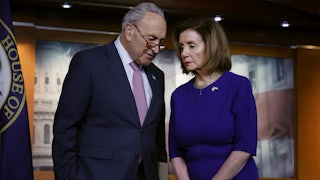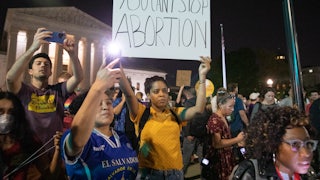In January 2016, the biggest pro-life event of the year was a bust. As a blizzard dropped some two feet of snow on D.C., thousands of would-be March for Life attendees stayed home, leaving just a fraction of the annual rally’s typical crowd. And beyond the inclement weather, things weren’t looking so great for the cause: In less than a year, most people supposed, Hillary Clinton would assume the presidency and start nominating judges specifically chosen to uphold abortion rights.
But if the mood at the snowed-out anti-abortion march hinted at imminent failure, within weeks the movement would be pleasantly surprised: Supreme Court Justice Antonin Scalia’s death left behind an eight-judge court split more or less ideologically in half. Senate Majority Leader Mitch McConnell famously propped the vacancy open until Trump took office; Trump replaced Scalia and intermittent abortion tolerator Anthony Kennedy with Neil Gorsuch and Brett Kavanaugh, plucked from a list devised to assuage concerns about the ex–reality show host’s candidacy from all throngs of the right, who needn’t have worried. Finally, mere weeks before the 2020 presidential election, another star aligned for conservatives with the death of Justice Ruth Bader Ginsburg. In short order, Ginsburg was replaced by Amy Coney Barrett, an archconservative from Notre Dame whose anti-abortion bona fides were so ironclad that in a newspaper ad she once explicitly called to strike down Roe v. Wade.
Barrett’s appointment solidified a decisive shift on abortion rights, tilting the plausibly anti-Roe forces toward a 6–3 majority that could afford to lose a swing vote and still disable the 49-year-old precedent. The pro-life movement acted accordingly, advancing bold provocations it may have avoided under a more liberal court. Texas passed a convoluted law designed to evade precedent law by letting any old shmoo file civil suits against whoever abets an abortion after six weeks; the judiciary took no action to stop it. And in December 2021, the court majority appeared swayed by oral arguments for Dobbs v. Jackson Women’s Health Organization, the Mississippi case poised to serve as a pretext to overturn all or part of Roe v. Wade. This May, Politico leaked a draft decision that seemed to confirm it would.
Some pro-choicers—understandably devastated to see Republicans within striking distance of fulfilling a decades-long campaign promise—hold out hope that Roe’s fall could be galvanizing. After all, well over half of Americans support legal abortion in many or all circumstances; as few as 20 percent report wanting Roe overturned outright. Politico noted that its scoop had “instantly jolted Democrats ... and many hope it could change the tide of the midterm elections.” The reasoning echoes a previous warning, in The New York Times, that Roe’s fall “might take away a powerful tool for energizing conservative voters—and it might motivate liberal ones.” The Atlantic similarly insisted that Republicans had “awakened America’s pro–abortion-rights majority.” This analysis even has purchase among Republicans. As one GOP pollster put it to the Associated Press, “It is going to be a very motivating issue for women who haven’t typically been single-issue pro-choice voters.”
Such optimism will likely prove unfounded: To suggest that the collapse of Roe could effectively inspire the sort of movement-building for the broader left that it has for the right is to misunderstand at once the class politics of abortion and the role it’s played within both parties. As much as we might wish otherwise, the most plausible impact the end of Roe v. Wade will have on electoral politics is little to none at all.
The basic story of how abortion became a cause célèbre for the Republican Party goes like this: In the postwar United States, when the coalitions that made up each major party looked very different from today’s, abortion was controversial but not an issue that split opinion along partisan lines. Even Ronald Reagan, whose political star rose after he lent his Hollywood charm to propaganda for the anti-Medicare campaign, signed a bill loosening abortion restrictions as governor of California in 1967. In 1970, Republican New York Governor Nelson Rockefeller signed into law the country’s most liberal abortion law; in 1972, pro-choice feminists like Jill Ruckelshaus attended the Republican National Convention as delegates.
Early organized blowback to the 1973 Roe decision was limited mostly to working-class Roman Catholics, who tended to vote for Democrats. (Within days of the ruling, my Irish grandparents dragged my 11-year-old mother to an anti-Roe protest in Chicago, where she was given a bracelet emblazoned with the date January 22, 1973, and told to wear it until Roe was overturned. To her credit, she has not.) Meanwhile, civil rights advances and desegregation efforts in the 1960s and 1970s drove a racist backlash among white Southerners, who began exiting the Democratic Party for the GOP and tapping into a defensive identity politics centered on Christianity rather than on explicit white supremacy. At around the same time, the booming postwar manufacturing sector began to grow sluggish, leaving an opening for capital to launch a counterattack on labor and blunt its decades of ascendancy, a historical and political process known as neoliberalism. (The high-water mark for union membership came in 1979, not long after Roe v. Wade.) The business factions of the Republican Party grew stronger, and the labor factions of the Democratic Party grew weaker, until finally, amid significant cultural and electoral upheaval and at the start of a still ongoing top-down siege on the poor and working class, Ronald Reagan’s 1980 presidential campaign managed to cobble together the coalition that’s defined American politics ever since: an ultrarich ruling class exclusively committed to serving the interests of capital, and the so-called religious right, which ably racks up votes for the former by drumming up angst about race, gender, and “morality.” Outrage over abortion—and, not so subtly, over the mouthy women’s libbers who seemed to love it so much—soon proved to be a particularly powerful flag to plant.
With his reconstituted Republican base, Reagan won two eye-popping landslide elections for president in a row. Realizing the centrality of the pro-life movement to his political brand, in 1985 he became the first sitting president to address the March for Life. For its part, the swath of the GOP preoccupied with business interests got plenty of juice for the squeeze: Abortion and other ostensibly moral issues continued to turn out voters for the Republican Party, which morphed into an extraordinarily effective wish-fulfillment vehicle for the country’s plutocrats: In the 1980s and 1990s, the right managed to slash taxes, decimate unions, liquidate pensions, corporatize health care, capture regulatory agencies, and more. Meanwhile, the pro-life movement operated as a sort of Get Out the Vote operation, delivering intermittent strikes against Roe such as 1992’s Planned Parenthood v. Casey, which opened the door to all manner of restrictions, so long as they didn’t constitute an “undue burden” on choice. Since the 1980s, pro-life activists have also targeted abortion clinics and providers—bombing and assassinating them, in extreme cases; barraging them with legal hoops to jump through; coercing providers into the provision of medically unnecessary ultrasounds and messaging; and lobbying for parental notification requirements, mandatory wait times, and so on.
Supporters of abortion rights have of course offered responses of their own. But if pro-choice activists have always been clear-eyed about the need to defend reproductive choice against attacks from the right, their analysis of the stakes hasn’t always been right. Nothing in recent years better illustrates erroneous mainstream interpretations of Roe than the ubiquity of cloak-and-bonnet costumes at pro-choice demonstrations. The outfits invoke the classic novel and TV adaptation of The Handmaid’s Tale, which imagines a dystopia that relegates women to incubator status. Suffice it to say that the overwhelmingly white professional-class women who don these costumes don’t inhabit a country on the verge of becoming a theocracy or even a patriarchy, but an oligarchy—the harms of which they’ll be relatively spared from.
That’s the too seldom articulated truth that puts bitter U.S. abortion battles into context: Wealthy and powerful women will always be able to get one. Long before legal abortion, in fact, those with means could afford higher-caliber surreptitious providers or travel elsewhere to get care they needed. And even in a post-Roe world, corporate executives who don’t want to be pregnant won’t be forced to remain so. The same can’t be said of poor women, disproportionately women of color. Meanwhile, at the margins of abortion access, the ongoing machinations of pro-life zealots have won plenty of concession prizes that force the poor through demeaning rigmarole they can’t afford. For the women who need abortion most, access to it has already seriously dwindled, and whatever options they do have may be prohibitively expensive, thanks to the Hyde Amendment, introduced in 1976, which blocked Medicaid coverage of the procedure. Back when Roe was decided, the prototypical abortion patient was young, white, highly educated, and ambitious, and seeking an abortion to fulfill career goals, self-actualize, or postpone a family—all perfectly valid reasons that nonetheless differ from those expressed by the typical abortion patient today, who is older with children already, Black, and low-income, and who usually reports opting for abortion because she can’t afford another child. In short, the anti-abortion movement is class war disguised as culture war, and reproductive justice must entail not just the right to abortion but resource redistribution and funding of the sorts of universal programs that the far right has used issues like abortion to block. (Compare a comprehensive reproductive justice demand to the pro-choice movement’s political strategy, which in no small part amounts to giving money to corporate Democrats.)
Once you reframe abortion as a top-down class war, it’s easy to see why the fall of Roe won’t amp people up the way some expect it to. While higher-class women understandably see Roe as a powerful guarantor of their personhood and equal status with men, poorer women have already lacked Roe’s protections for a long time—and it’s unclear whether an oppressed population already long under political siege and less likely to vote will be thrust toward an epiphany by a SCOTUS ruling. In polls, the people who report caring most about abortion relative to other issues are young, progressive, educated, concentrated in cities, and of higher income—already one of the Democratic Party’s strongest bases. The moderate suburban voters some analysis predicted could be brought into the Democratic fold have largely already entered, in 2018 and 2020—and even if they disapprove of overturning Roe, polls suggest they may not care quite enough to prioritize it over other issues.
Nor does it seem likely that Republicans will be rewarded if they deliver a major pro-life victory this summer. Abortion has already passed its apex as a cause for Republican voters, with the number opposing it actually dipping slightly in recent years. The party has long since moved on to riling people up over other shameful social projects, like terrorizing trans children and getting books banned from libraries—issues that can be swapped in fairly seamlessly for abortion as far as mobilizing voters goes. And just as they did decades before, those right-wing voters—with their convenient geographical distribution relative to liberal city folk, the Senate being what it is—are summoned to uphold every advantage of capital. The political solution to that—and to securing reproductive rights in the process—must be deeply rooted in class, just as abortion always has been.






